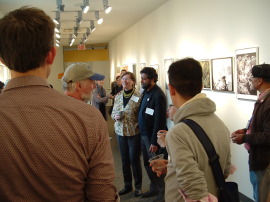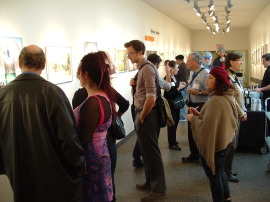 Radial Development by Robert Fathauer – 2014 – ceramic sculpture (one of 42 selected works for The Brain exhibition)
Radial Development by Robert Fathauer – 2014 – ceramic sculpture (one of 42 selected works for The Brain exhibition)
From functional Magnetic Resonance Imaging (fMRI) and 3D Brain Maps to Cognitive (Neural Network) Models and ‘Neuromorphic’ Computer Chips…Brain Science is all the rage these days amongst scientific researchers and the world-wide science press. And certainly, the scientifically interested public is equally excited, what with new technologies and advances happening at a frenetic pace — all holding out the potentials and promises (and perils?) of a ‘New Age’ of neuroscience discovery and astounding applications.
This intense interest in moving brain science to the next level is reflected in Big Science projects happening on two continents: in the US, President Obama has announced the BRAIN (Brain Research through Advancing Innovative Neurotechnologies) Initiative, and, in Europe, the Human Brain Project (HBP) is underway (but not without the usual Euro-controversies over who controls/directs the project). There is also the Human Connectome Project (HCP) – a public-private partnership that endeavors to produce an “unparalleled compilation of neural data” and ultimately a complete map of the brain’s 100 billion neurons and its 100 trillion synaptic connections. And these are just the most high-profile efforts.
This intense preoccupation with new brain research and technology is perhaps nowhere more keen and dynamic (outside of the science labs themselves) than in the Arts, where a host of visual and multimedia creatives are engaging in their own ideosyncratic and aesthetic forms of “cerebral exploration” as they seek to grapple with the images, ideas, knowledge and advances proffered by this brave new world of “neurosci.”
‘The Brain’ Exhibition in NYC – Capturing Deep Aesthetics and Wider Meanings
“These “heady” times for neuroscience are also having a domino effect in the arts. Artists have long reflected upon the nature of perception, memory, and emotion to create their work. But recent breakthroughs in understanding the brain, accompanied by its visualizations, are sparking the imaginations of artists around the world.” – Cynthia Pannucci, founder/director of ASCI and organizer of The Brain exhibition
The 16th international art-science juried exhibition, organized by Art & Science Collaborations, Inc., in promotional partnership with Meghan Rhodes and MEDinArt, is currently open for public viewing at the New York Hall of Science (located in Queens, NYC). The exhibition is the culmination of an international open call for “visually stunning” works of art inspired by brain science (and however one wished to interpret the knowledge products of this science).
 Cortical Columns by Gregory Dunn, 2014 (one of 42 selected works for The Brain exhibition)
Cortical Columns by Gregory Dunn, 2014 (one of 42 selected works for The Brain exhibition)
True to its name (Art – Science Collaborations), the final works included in the exhibition (which opened in October, 2014) were selected by a two panel jury consisting of one actual neuroscientist — Dr. Anjan Chatterjee (the Elliott Professor and Chief of Neurology at Pennsylvania Hospital at the University of Pennsylvania) — and one artist — Stephen Nowlin (director of the Alyce de Roulet Williamson Gallery at Art Center College of Design in Pasadena, California).
Dr. Chatterjee — whose specialty is “neuro-aesthetics” — describes his experience in first viewing the submitted art work:
“In reviewing the submissions for this exhibit, it has been fascinating to peek at the brain from another side, a side conceived by artists. Their goal is not so much communicating the veracity of data, as it is the truth of the matter. I am struck by the sheer beauty and elegance of these artistic representations of neurons, the landscape they inhabit, their connectedness in orchestrating our minds, and their reach into the world through health and disease.”
And, artist and gallery director Stephen Nowlin offered his aesthetic impetus for his art selections:
“In looking through the entries, I gravitated to a group that engaged the dense and seemingly incomprehensible complexities of the brain’s neural networks.“
The remote collaboration between scientist and artist resulted in the curating of 42 (2D) works by 29 artists hailing from Israel, Italy, France, Germany, Canada, Mexico, and all over the US. [Disclosure: this author was one of the 29 artists whose work is included in this exhibition].
 ASCI Director Cynthia Pannucci and co-juror Anjan Chatterjee of UPenn (center) speak to The Brain artists reception crowd (click on images for sharper resolution viewing – photo: M Ricciardi)
ASCI Director Cynthia Pannucci and co-juror Anjan Chatterjee of UPenn (center) speak to The Brain artists reception crowd (click on images for sharper resolution viewing – photo: M Ricciardi)
The Brain Matters – Artistic Views on Our Brainy Being
Not all art works in the exhibit chose to focus on the technological or “objective” physiological aspects of brain research; many of the selected works took inspiration from a more personal and/or socially aware perspective on the brain, with a few dealing with various brain disorders (like Cotard’s Syndrome) and even chronic pain conditions like migraines. A few works even offer a refined dose of unexpected humor and a dark, anitquated, grotesquerie.
Overall, the collected works offer a compelling visual celebration (or cerebration) of that fatty blob of gray and white matter that we all carry around in our skulls, and which transmutes multiplicitous sensory perception into irreducible aesthetic experience.
What follows is a varied but limited selection of the included art works (including one image from the recent artists reception on October 26). For a complete viewing of artworks (low resolution jpeg images) in the The Brain exhibition, visit this dedicated ASCI webpage (with full artist statements!).
But, if you would prefer to see the works in their full-size, real-world manifestations, the exhibition runs through March 29, 2015 in the LeCroy Gallery space at the family friendly New York Hall of Science. After that, a world tour is in the works. And, if you are interested in having The Brain exhibition tour in your part of the world (at your college, university, research center or art center/gallery), contact ASCI director Cynthia Pannucci at the provided email address on the asci.org website.
A Taste of The Brain – A Few Selected Works from THE BRAIN Exhibition:
 Evolving Man by Debra Friedkin, 2013, mixed-media collage on paper
Evolving Man by Debra Friedkin, 2013, mixed-media collage on paper
 Anatomical No-Body Brain Drawing (triptych-left) by Federico Carbajal, 2012-2013, mixed-media on wood
Anatomical No-Body Brain Drawing (triptych-left) by Federico Carbajal, 2012-2013, mixed-media on wood
 Untitled from “Life Science” Series 1 by Eran Gilat, 2012, Lambda digital C-print
Untitled from “Life Science” Series 1 by Eran Gilat, 2012, Lambda digital C-print
 Augmented Humans by Gunes-Helene Isitan, 2008, digital photo
Augmented Humans by Gunes-Helene Isitan, 2008, digital photo
 MachuP Map by Ron Wild, 2014, original digital montage C-print
MachuP Map by Ron Wild, 2014, original digital montage C-print
 Cotard’s Syndrome by Remy Nurse, acrylic on paper
Cotard’s Syndrome by Remy Nurse, acrylic on paper
 Nocturne: Waltzing With St. Vitus by Terri Lloyd, 2013, archival digital print
Nocturne: Waltzing With St. Vitus by Terri Lloyd, 2013, archival digital print
 Universal Noise by Robert Peters, 2014, archival inkjet print
Universal Noise by Robert Peters, 2014, archival inkjet print
 Incremental Steps 1 by Aga Tamiola, 2012, mixed-media on paper
Incremental Steps 1 by Aga Tamiola, 2012, mixed-media on paper
 Su Brain Tracts Renew by Lia Cook, 2014, woven cotton and rayon
Su Brain Tracts Renew by Lia Cook, 2014, woven cotton and rayon
 Artists reception for The Brain exhibition, Oct. 26, 2014 (note: gray-haired gentleman at center-right with shoulder strap is Bell Labs alumnus and Interactive Media pioneer Jerry Spivak; photo: MRicciardi)
Artists reception for The Brain exhibition, Oct. 26, 2014 (note: gray-haired gentleman at center-right with shoulder strap is Bell Labs alumnus and Interactive Media pioneer Jerry Spivak; photo: MRicciardi)
Lastly, watch a rapid-cycling .gif animation of this blog author’s jury-selected work ‘CogMod – Multi-Layer Neural Network(ing)’ (“the making of”).
All images copyrighted by the respective artists and used here with permission from asci.org